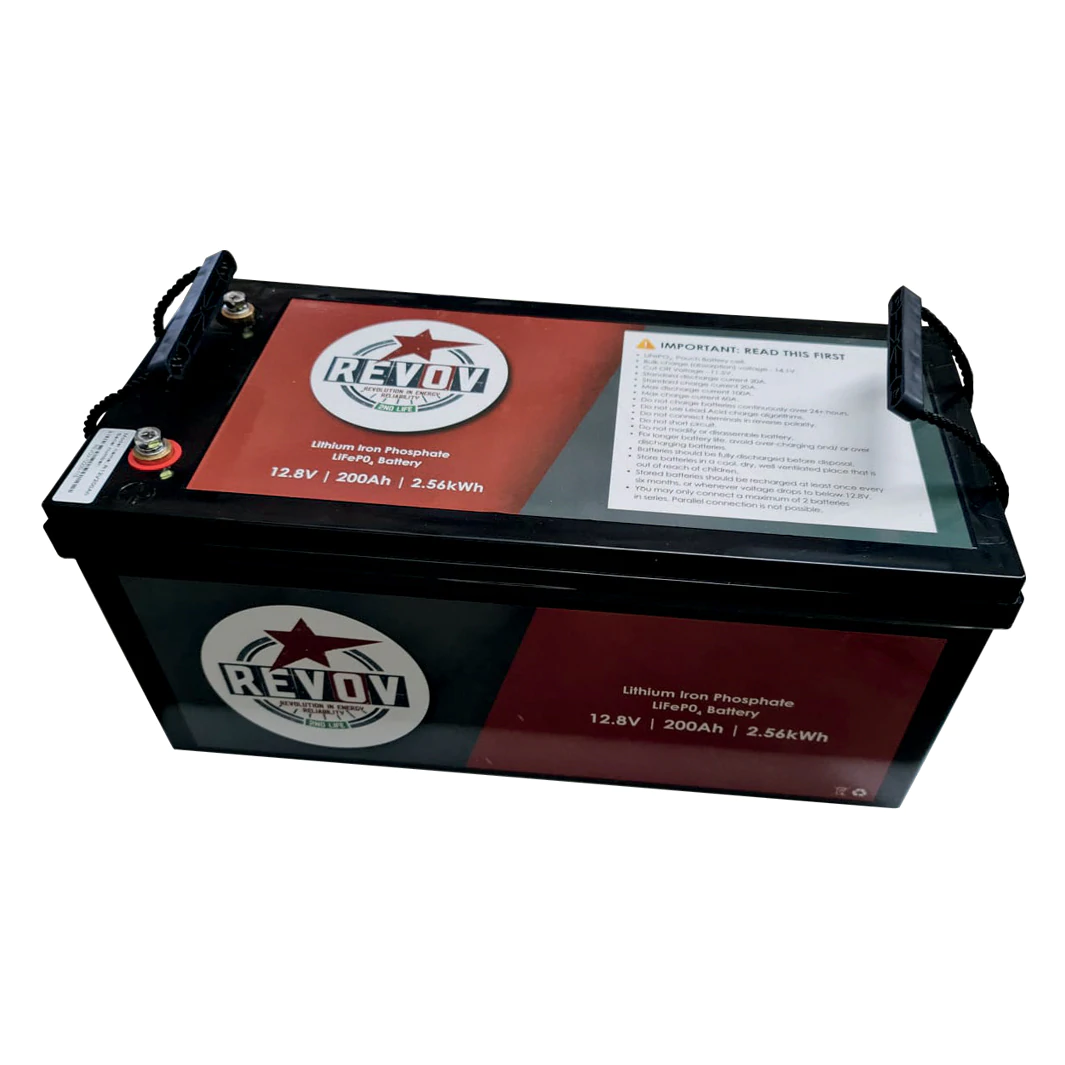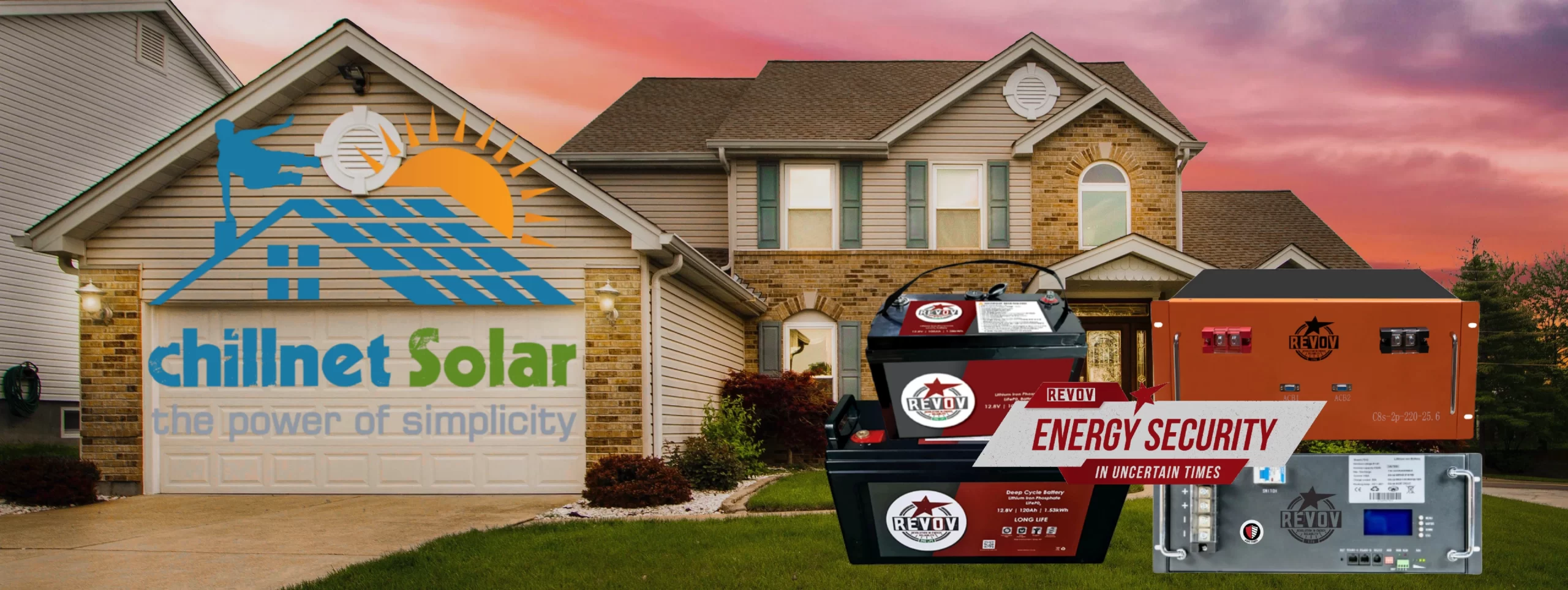REVOV 2nd LiFe 200Ah LiFePO4 Battery
Original price was: R11,347.05.R10,474.20Current price is: R10,474.20. incl Vat
8% Off
Available on backorder
REVOV 2nd LiFe 200Ah LiFePO4 Battery
REVOV’s 12V 200Ah 2.56kWh lithium iron battery is ideal for portable energy storage – and because it uses 2ndLiFe technology, it is highly cost-effective.
Our 12V 200Ah lithium ion battery includes an integrated battery management system and a durable ABS enclosure.
The battery uses a superior four-cell configuration, with advanced LiFePO4 chemistry. It is designed to withstand harsh conditions (including high temperatures) and offers long life span and high energy density.
Description
REVOV 2nd LiFe 200Ah LiFePO4 Battery
REVOV 2nd LiFe batteries are repurposed after use in electric vehicles. This makes them less expensive than comparable alternatives. They are also environmentally responsible, reducing electronic waste and repurposing important materials.
REVOV’s 200ah 12.8v 2.56 kwh lithium ion battery is the perfect replacement for all GEL and Lead acid batteries. Switch and get nearly double the performance. It is compact, lightweight and durable. The Revov 12V 200ah battery uses LiFePO4 for greater energy density and long lifespan. With integrated battery management this battery is the most cost effective for your Solar or backup system.
The most economical battery replacing the older 200ah batteries:
- Lithium Iron Phosphate (LiFePO4) technology.
- Integrated battery management System (BMS).
- Light weight & compact.
- Water & dust resistant (IP56).
- Built in BlueTooth Battery management System.
Key Features
REVOV 2nd LiFe 200Ah LiFePO4 Battery
- Lithium Iron Phosphate (LiFePO4) technology.
- Integrated battery management System (BMS).
- Light weight & compact.
- Water & dust resistant (IP56).
- Highly durable ABS enclosure.
- Drop-in lead acid replacement (with LI consideration) for static storage.
- The battery can be connected in series up to 24V.
- Under and over voltage protection.
- The Bluetooth app allows for the display of the battery’s Total Voltage, Remaining Voltage,
- Temperature and Time Left until fully Discharged.
- Warranty: 3years or 2000 Cycles.
Battery Specifications
REVOV 2nd LiFe 200Ah LiFePO4 Battery
-
- Nominal Capacity: 200Ah.
- Nominal Energy: 2560Wh.
- Nominal Voltage: 12.8V.
- End of Discharge Voltage: 11.5V.
- Standard Charge Voltage: 14.1±0.2V.
- Float Charge Voltage: 13.7V.
- Standard Charge Current: 40A.
- Operating Current: 0 – 100A.
- BMS peak Current: 150A,10Sec.
- Internal Resistance: 20mΩ.
- Weight Approx.: 23kg.
- Ex-factory Capacity SOC Approx.: 50% SOC.
- Discharge Temperature: -20° C – 60°C.
- Charge Temperature (must be reduced at 0°C – 5o°C) 5° C – 45° C.
- Recommended Storage Environment 15 – 45oC @ 75% SOC.
- Cycle Storage: 1 FULL cycle within 6 months.
- Maximum DOD: 90%.
- Cells: Prismatic LiFePO4.
Electrical Characteristics
REVOV 2nd LiFe 200Ah LiFePO4 Battery
- Nominal Capacity: 120Ah.
- Internal Impendence: 40mΩ.
- Protections: Short Circuit Protection under and over Voltage Protection, Auto Cut-off Load when Short Circuit.
Lithium-Ion Batteries
High energy density
A LiFe battery lasts much longer between charges compared to what a lead acid battery can deliver. It also loses little to no charge when not in use.
When used properly each day, a LiFe battery can be discharged to 80% or higher of its rated capacity before it should be recharged.
In fact, the batteries we offer at REVOV can be safely discharged to 100% of their rated capacity, for example in backup situations.
By comparison, lead-acid batteries generally have a maximum daily depth of discharge (DoD) ranging from 20 to 40%.
Long lifespan
A key advantage of REVOV’s lithium-ion batteries is their long lifespan. LiFe batteries are significantly longer-lasting than competing alternatives. This makes them more cost-effective.
Even our REVOV 2nd LiFe 200Ah LiFePO4 batteries, which have served as electric vehicle batteries prior to being repurposed as stationary energy storage systems, come with a warranty for 10 years (or 3500 cycles at one cycle per day, whichever comes first).
Depending on how it’s used, a new lithium-ion battery could last as long as 25 years.
By comparison, the average life span of a lead acid battery is just two years.
Fast charging
Lithium-ion batteries charge faster than comparable alternatives. This reduces downtime and boosts efficiency.
On average, LiFe batteries charge four times faster than lead-acid batteries.
Zero maintenance
Lithium batteries require no maintenance. This reduces their cost of ownership, as well as making them easier and safer to use.
Lithium batteries can also be stored for longer than lead-acid batteries because of their low self-discharge rate (they lose very little power when idle).
Battery safety
Lithium-ion batteries have no fuel to refill or dangerous acid to replace – and unlike generators, they don’t emit any fumes.
REVOV batteries use only the highest quality cells and feature reliable, easy-to-use battery management systems.
The technology they use (lithium iron phosphate) is the safest battery technology currently available.
Extreme temperature resilience
Lithium iron phosphate batteries can withstand a wide range of temperatures.
Our batteries – including the LiFe REVOV C8 and REVOV B100 and the 2ndLiFE REVOV R9 and REVOV R100 – can charge at temperatures from zero to 45° Celsius. They can discharge at temperatures from -20° to 60° Celsius.
Because of their temperature resilience, these batteries are suitable for use in extreme weather conditions. They’re also safer than other lead batteries for applications that may exhaust battery capacity.
Compact and lightweight compared to lead acid batteries
REVOV 2nd LiFe 200Ah LiFePO4 Battery and LiFe batteries are lighter and much smaller than other batteries that offer comparable performance. They provide greater energy density at half the mass, or less, of lead-acid batteries.
This makes them easier to transport and house, and suitable for wall mounting.
LiFePO4 batteries: what are they?
Batteries made on lithium iron phosphate are known as LiFePO4 (REVOV 2nd LiFe 200Ah LiFePO4 Battery) batteries. Various other lithium batteries are as follows:
- Oxide of Lithium Cobalt (LiCoO22)
- Oxide of Lithium Nickel Manganese and Cobalt (LiNiMnCoO2)
- Titanium Lithium (LTO)
- Manganese Oxide in Lithium (LiMn2O4)
- Oxide of Lithium Nickel Cobalt (LiNiCoAlO2)
- Some of these substances may be familiar to you from chemistry. You probably spent a lot of time there memorizing the periodic table or simply gazing at it on the teacher’s wall. You conducted your tests there (or, stared at your crush while pretending to pay attention to the experiments).
- Of course, occasionally a student who loves experiments goes on to become a chemist. The ideal lithium battery combinations were also found by chemists. That’s the quick version of how the birth of the LiFePO4 (REVOV 2nd LiFe 200Ah LiFePO4 Battery) battery. (By the University of Texas, specifically, in 1996). The safest, most trustworthy, and most stable lithium battery is now known as LiFePO4 (REVOV 2nd LiFe 200Ah LiFePO4 Battery).
A Synopsis of LiFePO4 Battery History
- Arumugam Manthiram and John B. Goodenough invented the LiFePO4 battery. The components used in lithium-ion batteries were initially discovered by them. Materials used as anodes in lithium-ion batteries are not particularly suited. This is due to their propensity for premature short-circuiting.
- Researchers found that cathode materials make better lithium-ion battery substitutes. And the LiFePO4 battery versions make this very evident. Fast-forward, boost conductivity and stability – all kinds of improvements, and poof! The birth of LiFePO4 (REVOV 2nd LiFe 200Ah LiFePO4 Battery) batteries.
- Rechargeable LiFePO4 batteries are widely available nowadays. These batteries are utilized in a variety of practical applications, including solar panels, automobiles, boats, and more. LiFePO4 batteries lack cobalt and are less expensive than the majority of their substitutes (over time). It lasts longer and is non-toxic. But more on that will be covered later. The LiFePO4 (REVOV 2nd LiFe 200Ah LiFePO4 Battery) battery has very promising future possibilities.
What, then, is better about the LiFePO4 battery?
LiFePO4 vs. Lithium Ion Batteries
- Let’s talk about what makes LiFePO4 batteries superior to lithium ion and other lithium batteries now that we are aware of what they are.
- Wearable electronics like watches are not well suited to the LiFePO4 battery. due to the fact that they don’t have the same energy density as other lithium-ion batteries. However, it is by far the ideal for things like solar energy systems, RVs, golf carts, bass boats, and electric motorcycles. Why?
- For starters, a LiFePO4 (REVOV 2nd LiFe 200Ah LiFePO4 Battery) battery has a cycle life that is over 4 times longer than that of other lithium ion batteries.
- Additionally, compared to lithium ion and other battery types, it is the safest form of lithium battery on the market.
- Finally, LiFePO4 batteries not only have a lifespan of 3,000–5,000 cycles or more… They are able to discharge at full depth (DOD). Why is that relevant? Because of this, LiFePO4 batteries (unlike other batteries) eliminate the risk of overcharging.
- As a result, you can utilize it for a longer duration. A quality LiFePO4 battery can actually be used for many more years than other battery kinds. It has an estimated 5,000 cycle life. It’s around 10 years, then. The average cost over time is thus significantly better. This is how LiFePO4 batteries compare to lithium ion batteries.
Safe, Stable Chemistry
- Safety for lithium batteries is crucial. That has been made abundantly evident by the recent “exploding” lithium-ion laptop batteries. Safety is one of LiFePO4’s most significant advantages over other battery types. The most secure sort of lithium battery is LiFePO4. Actually, it’s the safest type of all.
- Overall, the most secure lithium chemistry is found in LifePO4 (REVOV 2nd LiFe 200Ah LiFePO4 Battery) batteries. Why? due to the greater thermal and structural stability of lithium iron phosphate. Lead acid and the majority of other battery types don’t have this to the same degree that LiFePO4 does. LiFePO4 is not flammable. It resists decomposition in high temperatures. It will maintain a cool temperature at room temperature and is not prone to thermal runaway.
- A LiFePO4 battery won’t catch fire or blow up if exposed to extreme temperatures or risky situations (such as short circuiting or a crash). This information is reassuring for people who often utilize deep cycle LiFePO4 batteries in an RV, bass boat, scooter, or liftgate.
Environmental Safety
- Because LiFePO4 (REVOV 2nd LiFe 200Ah LiFePO4 Battery) batteries can be recharged, they already benefit the environment. However, their environmental friendliness goes farther. They are non-toxic and won’t leak, in contrast to lead acid and nickel oxide lithium batteries.
- They can also be recycled. However, since they endure for 5000 cycles, you won’t need to do that frequently. In other words, you can recharge them 5,000 times at the very least. Lead acid batteries, in contrast, only survive 300–400 cycles.
Excellent Efficiency and Performance
You desire a toxic-free, secure battery. However, you also want a battery that will work well. These figures demonstrate how LiFePO4 provides all of that and more:
- Charge efficiency: a LiFePO4 battery will reach full charge in 2 hours or less.
- Self-discharge rate when not in use: Only 2% per month. (Compared to 30% for lead acid batteries).
- Runtime is higher than lead acid batteries/other lithium batteries.
- Consistent power: same amount of amperage even when below 50% battery life.
- No maintenance needed.
Small and Lightweight
- The improvement of LiFePO4 (REVOV 2nd LiFe 200Ah LiFePO4 Battery) batteries depends on a number of parameters. They are complete lightweights, speaking of weight. They actually weigh about 50% less than lithium manganese oxide batteries. They can be up to 70% lighter than lead acid batteries in terms of weight.
- Less petrol is used and improved maneuverability are the results of using a LiFePO4 battery in a car. Additionally, they are small, which frees up room on your scooter, boat, RV, or other industrial application.
LiFePO4 Batteries vs. Non-Lithium Batteries
LiFePO4 triumphs over lithium ion in the comparison between the two. However, how do LiFePO4 batteries stack up against other rechargeable batteries now available?
Lead Acid Batteries
Although lead acid batteries initially appear to be a good deal, they will ultimately cost you more money. That’s because you have to replace them more frequently and maintain them constantly. A LiFePO4 (REVOV 2nd LiFe 200Ah LiFePO4 Battery) battery will last 2-4 times longer and requires no maintenance.
Gel Batteries
Gel batteries do not require frequent recharging, like LiFePO4 batteries. They won’t lose charge either when being stored. Where does LiFePO4 and gel diverge? The charging process is a significant factor. Gel batteries charge quite slowly. In order to avoid damaging them, you must unplug them when they are fully charged.
AGM Batteries
When AGM batteries are discharged past 50% of their capacity, they put themselves and your pocketbook at great danger of damage. It can be challenging to maintain them as well. Lithium-ion LiFePO4 (REVOV 2nd LiFe 200Ah LiFePO4 Battery) batteries can be fully discharged without sustaining any damage.
MORE ABOUT REVOV
REVOV is an energy storage solutions company that sells carry-case sized lithium-iron batteries. These are available as single units or in powerful systems of up to MWh sizes.
REVOV was founded in 2016 and has sold in excess of 20,000 batteries.
Our customers include wholesalers, installers and end users.
Backup power and renewable energy solutions
REVOV batteries can be charged directly from the electricity grid, to provide backup power to commercial, industrial or residential facilities.
Alternatively, they can be connected to renewable energy sources such as solar panels or wind turbines to provide continuous renewable energy
Energy storage solutions in South Africa and beyond
REVOV’s battery solutions directly address:
the current insecurity of the electricity grid in South Africa
variability in supply from renewable energy sources
growing demand for energy storage in the rest of Sub-Saharan Africa
the global call to reduce carbon emissions
Additional information
| Weight | 22 kg |
|---|---|
| Dimensions | 50 × 23.5 × 22 cm |
| Brand name |




